By Sarah Sinning
Last month, the Centers for Disease Control released their “Interim Guidance for Emergency Medical Services and 911 Public Safety Answering Points for COVID-19 in the United States.”
In addition to calling for “close coordination and effective communications” between all emergency response stakeholders – 911 call centers, the EMS system, healthcare facilities and the public health system – the guidelines also strongly encouraged “the involvement of an EMS medical director” for “appropriate medical oversight” of a rapidly evolving situation.
What follows is an overview of these guidelines, complete with the most up-to-date revisions.
RECOMMENDATIONS FOR 911 PSAPS
- Create modified caller queries as appropriate, using the guidance of an EMS medical director as well as local, state and federal health authorities.
- Dispatchers should question callers to determine risk of infection.
- All patients meeting the appropriate criteria should be transported as a person under investigation.
- Information on a possible PUI should be communicated to EMS clinicians before arrival on scene.
- PSAPs responding to ill travelers at international ports of entry should be in contact with the appropriate CDC quarantine station for guidance.
RECOMMENDATIONS FOR MEDICAL FIRST RESPONDERS
- If dispatchers advise that COVID-19 infection is suspected, EMS clinicians should put on full list of appropriate PPE (see below).
- Regardless of PSAP directive, clinicians should exercise precautions when responding to patients with any signs of upper respiratory infection, including performing initial assessments from a distance of at least six feet.
- Contact should continue to be minimized until a facemask is in place on the patient. If a nasal cannula is in place, a facemask should be worn over it. An oxygen mask can also be used if clinically indicated.
- Only essential personnel should ride in the patient compartment during transport.
RECOMMENDED PERSONAL PROTECTIVE EQUIPMENT
- N-95 or higher-level respirator or facemask (if a respirator is not available). The CDC has also issued guidance for proper N-95 respirator use, including how to ensure a proper fit.
- Eye protection that fully covers the front and sides of the face. Personal eyeglasses and contact lenses are NOT considered adequate.
- A single pair of disposable patient examination gloves, which should be changed if they become torn or heavily soiled.
- Isolation gown (unless there is a shortage, in which case gowns should be reserved for aerosol-generating procedures)
- Anyone directly involved in patient care, including drivers who move patients onto stretchers, should wear appropriate PPE. Remove PPE once contact has ceased (i.e. before getting into isolated driver’s compartment)
- Remaining EMS clinicians should remove and discard PPE once patient is released to facility
RECOMMENDED PPE: AEROSOL-GENERATING PROCEDURES
- An N-95 or higher-level respirator, instead of a facemask, should be worn in addition to the other PPE described above.
- BVMs, and other ventilatory equipment, should be equipped with HEPA filtration to filter expired air.
- Rear doors of transport vehicle should be opened (if possible) and HVAC system should be activated during procedure.
EMS TRANSPORT OF PUI
- Clinicians should notify receiving healthcare facility of patient status, including signs and symptoms of COVID-19 infection.
- Keep patient separated from other people as much as possible; no one other than medical personnel should ride with the patient, including family members.
- Isolate driver from patient compartment; if vehicle without isolated driver compartment must be used, open outside air vents in driver area and turn on rear exhaust fans to highest setting.
DOCUMENTATION OF PATIENT CARE
- All documentation should be completed after clinicians have completed transport, removed PPE and thoroughly washed hands.
- Documentation should include listing of all clinicians and public safety professionals involved as well as the level of contact with patient.
CLEANING TRANSPORT VEHICLES
- After transport, leave rear doors of vehicle open to facilitate removal of infectious particles; the time it takes to complete transfer and necessary documentation is sufficient.
- Wear disposable gown and gloves when cleaning vehicle, including a face shield or mask if splashes or sprays are anticipated.
- Doors should remain open when cleaning chemicals are in use to provide proper ventilation.
- Routine cleaning and disinfection procedures are appropriate.
- Products with EPA-approved emerging viral pathogen claims are recommended. Access list here.
- Follow standard procedures for disposing of PPE used while cleaning.
FOLLOW-UP
- State and local health officials should be notified so appropriate monitoring of the patient can occur.
- EMS agencies should develop policies for assessing and managing exposure risk, and should do so in coordination with public health authorities.
- Any unprotected exposure by clinician should be reported up the chain of command.
- Clinicians should be alert for the development of fever or other respiratory symptoms, again notifying the proper authorities and self-isolating if necessary.












